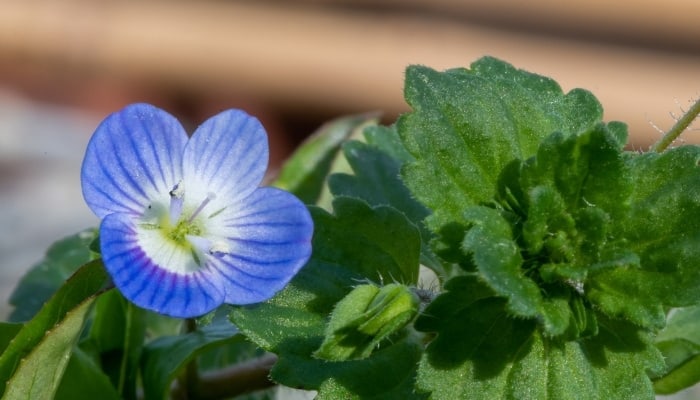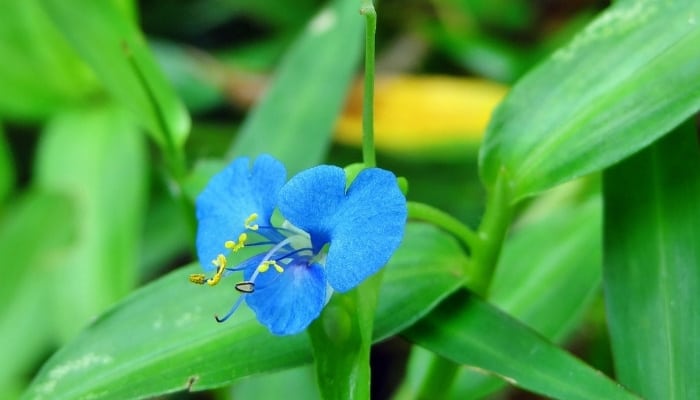It is not unusual for a lawn to grow various types of weeds amidst the turf grass that required significant investment and labor.
That doesn’t necessarily mean that the grass seeds you bought were contaminated with seeds of weeds.
Some of these invasive seeds are carried by the wind. When they land in your yard they will sprout in the moist and fertile soil.
What are the small blue flowers on my lawn? Weeds with blue flowers in your grass have different varieties. You can have corn speedwell, blue-eyed grass, tiny bluets, common blue violets, or Siberian squill. Carpetweed, Asiatic dayflower, and blue oxalis are common weeds with tiny blue flowers that sprout in lawns in the spring as well.
Despite their tiny blooms, these weeds are invasive plants that compete with the turf grass and should be removed either chemically or mechanically.
Read more to find out how to identify these different blue flowers in your grass and how to get rid of them.
10 Blue Flowers Often Found Growing in Grass
Before you set out to kill the weed with blue flowers in your grass, you need to identify the type of weed you’re dealing with.
This will help you narrow down the best way ways to eliminate it for good.
1. Corn Speedwell (Veronica arvensis)

The seeds of this plant are carried by the wind, especially in the spring and autumn. The mature plant reaches about 12 inches high and the same in width.
If you allow it to flower, the seeds will spread across the lawn, and the next spring, you’ll have weeds everywhere.
2. Blue-Eyed Grass (Sisyrinchium angustifolium)

With blue flowers that appear in the spring and last throughout the summer, this weed is quite attractive if you grow it in the garden, but in the middle of a meticulous lawn, the 20-inch tall plant sticks out like a sore thumb.
It’s drought tolerant, is hardy in zones 4 to 9, and comes back to life in the spring.
3. Tiny Bluets (Houstonia pusilla)

Growing up to only 6 inches tall, this weed can easily hide among the grass. Most likely you’ll only notice it when the blue flowers bloom in the late spring.
The self-sowing weed tends to spread and cover every inch of space available. If left alone, it will smother the grass and take over the whole lawn.
4. Common Blue Violet (Viola sororia)

If the blue violet shows up on your lawn, check if the plant is growing in a nearby garden. The blue flowers attract bees and butterflies. The wind carries the seeds and deposit them in lawns.
The mature plants average 8 inches high and bloom from March until May every year.
5. Siberian Squill (Scilla siberica)

The cold-hardy Siberian squill thrives in Zones 2 to 8. It’s a low-growing weed that barely reaches 6 inches at maturity.
If you allow your grass to grow tall, the Siberian squill will hide among the tall grass. It thrives in the same conditions as your turf grass.
6. Asiatic Dayflower (Commelina communis)

This weed blooms at dawn, and by noon, the flowers have wilted. If you don’t inspect your grass regularly in the morning, you can easily miss this weed.
It has thick and watery stems that branch out quickly to cover larger spots on the lawn.
7. Henbit (Lamium amplexicaule)

Henbit is another weed that grows low and has a spreading habit. It’s an annual, but that doesn’t make it less invasive.
It will deposit its seeds in the soil to germinate in the next spring. It blooms in the early spring in cold microclimates and throughout the summer and even in the winter in warmer zones.
8. Carpetweed (Ajuga pyramidalis)

This perennial herbaceous plant grows between 2 to 8 inches tall.
As the name implies, it carpets the lawn with its short stems that can easily evade the blades of the mower. Its blue flowers have nectar that attracts pollinators.
9. Blue Oxalis (Parochetus communis)

Blue oxalis is a kind of legume with clover-like leaves and blue blooms. It reaches between 4 to 8 inches tall and develops long pods containing between 8 to 12 seeds.
The pods crack open when ripe and dry to spread the seeds on the lawn.
10. Creeping Charlie (Glechoma hederacea)

This is an invasive plant that was introduced by the first settlers from Europe.
It grows aggressively and has a complex root system that makes it difficult to eliminate once it invades a lawn or a garden.
How To Get Rid of Lawn Weeds
Each one of the above weeds growing on your lawn requires a slightly different approach to eliminate it. In general, you can follow these steps.
- Identify the type of blue flower weed you’re dealing with.
- Use a pressure sprayer to spot-kill broadleaf weeds.
- Spray clumping weeds and those that grow in clusters with an herbicide.
- Weeds with deep roots should be pulled out one by one, or you can dig up the roots with a spade.
Best Product To Kill Weeds and Grow Grass
In most cases, a good weed killer will save you the trouble of having to dig up each weed by hand.
The following two weed killers not only eliminate various types of weeds on the lawn selectively but also feed the grass in the process.
Scotts Turf Builder Weed and Feed
Scotts Turf Builder is a weed killer that targets dandelions and clovers. It uses a WeedGrip technology that identifies several weeds hiding in the grass and eliminates them without damaging the grass.
At the same time, it contains nutrients that feed the grass and allows it to combat the invasive weeds.
GreenView Fairway Formula
This is more of a pre-emergence herbicide that you spray to prevent invasive weeds, such as crabgrass, from establishing on the lawn.
If there are weeds already growing among the grass, the powerful formula will kill them. It also doubles as a grass fertilizer with all the macronutrients that lawns need.
Conclusion
The blue flowers in your grass are a cause for concern. Most likely these are invasive weeds that would self-sow and spread across the lawn unless you take action to remove them either manually or chemically.

